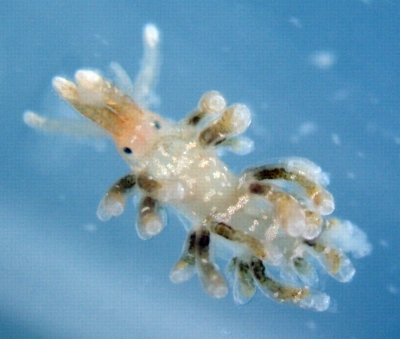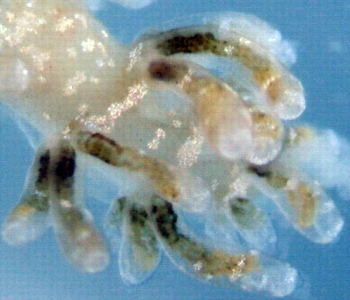Coral feeding - Relevant pages
Here is an index of pages dealing with coral-feeding opisthobranchs, and aspects of their biology and natural history.
•Coral feeding - radular adaptations
•Coral feeding - defensive adaptations
•Coral feeding - utilising different parts of the coral
•Cuthona poritophages
•Pinufius rebus - zooxanthellae symbiosis
•Pinufius rebus
•Phestilla lugubris
•Phestilla melanobrachia
•Phestilla minor
•Solar-powered Sea Slugs
•Zooxanthellae Symbiosis - references
Rudman, W.B., 1999 (October 6) Coral feeding - Relevant pages. [In] Sea Slug Forum. Australian Museum, Sydney. Available from http://www.seaslugforum.net/find/corafeed4
Related messages
Coral - feeding ? aeolid
July 29, 2006
From: Charles Raabe

This specimen was found at the base of an Acropora sp. and is my only real suspect as to the coral losing tissue.
Locality: Coral Reef, 15 feet, Philippines, Indo-pacific, 14 July 2006, reef . Length: less than 1 mm. Photographer: Charles Raabe.
This specimen is so small it took the aid of a microscope to get these images. Thank you.
Charles Raabe
charlesr1958@pacific.net.ph
Raabe, C., 2006 (Jul 29) Coral - feeding ? aeolid. [Message in] Sea Slug Forum. Australian Museum, Sydney. Available from http://www.seaslugforum.net/find/17154
Dear Charles,
I don't know of any aeolid whichs feeds on Acropora but I guess its certainly a likely candidate for a hungry aeolid. I have summarised most of what we know about coral feeding nudibranchs on a separate page. One way coral-feeding aeolids differ from other aeolids, which usually feed on hydroids and sea anemones, is that they have lost the cnidosac at the tip of the cerata. Instead the tips of their cerata are swollen with large gland cells, which I presume produce defensive secretions [see Coral-feeding - defensive adaptations ].
If you look at your animal, the tips of the cerata are a bit swollen and do seem to have glands at the tip, so it is possible that you have an aeolid feeding on Acropora. I am afraid the only way to be sure would be to leave the aeolid where it is and see if it grows and the Acropora continues to decline. I would suspect if it is small and you have noticed damage to the coral then there may be a group of these aeolids present. Probably not what you wish to hear, but very interesting to me.
Best wishes,
Bill Rudman
Relationship between nudibranchs & corals
March 2, 2001
From: Joanne
Hi,
I'm a student at the University of California, Santa Cruz, and am currently taking an ocean science class. I have to do a presentation as a final project for my class. My topic that I have chosen is the relationship between nudibranchs and corals. My main question is, is this relationship symbiotic, commensal, or parasitic? And I know that only some species are able to have this kinda of relationship, which species are they? Also the information I found about this topic is highly limited, it would be greatly appreciated if you can provide some info or possible links.
Thank you very much,
Joanne
sourgrey@aol.com
Joanne, 2001 (Mar 2) Relationship between nudibranchs & corals. [Message in] Sea Slug Forum. Australian Museum, Sydney. Available from http://www.seaslugforum.net/find/3872Dear Joanne,
There is a lot of information on coral-feeding nudibranchs in the Forum. As a general rule, if you are looking for information on the Forum use the SEARCH button. If you type coral, for example, you will get a list of relevant pages to go to. Your best bet would be to got to the Coral Feeding Index Page.
Are these animals parasites, commensals etc etc? It is all a question of definition. Is a large mammalian herbivore which only eats certain plants a parasite, a symbiont or commensal - or is it just a grazing herbivore? I remember Russell-Hunter in one of his books questioning why an enormous lion, feeding on prey much smaller than itself was considered 'noble and brave' while a flea or tick, living a perilous life feeding on an animal much larger than itself, was despised by us, its very name being used as a term of abuse.
I think it is more important to understand an animal's relationship to the other organisms they are associated with, rather than find them a label. Most of the nudibranch coral-feeders have a very close obligate relationship with a particular species of coral, and often they have modified their shape and colour to enable them to hide on their coral food, which becomes their home as well as their food. At the same time some of these nudibranchs have evolved a close relationship with the coral's symbiotic zooxanthellae, removing them from the coral and keeping them alive in their own tissues.
Read the information in the Forum on these fascinating animals and see how they fit the definitions you have for commensals, parasites etc.
Best wishes,
Bill Rudman
Sea slugs and coral?
October 7, 1999
From: Melissa H
What do sea slugs do to coral?
Melissa H
mconrad@uslink.net
Dear Melissa,
Some nudibranch sea slugs eat corals. Have a look at the Coral Feeding Page, where you will find an index of topics about coral-feeding nudibranchs.
Best wishes,
Bill Rudman.
Pinufius rebus and coral-feeding
October 7, 1999
From: Bill Rudman
I have prepared some pages on the incredibly cryptic coral-feeding nudibranch Pinufius rebus, and some pages on general aspects of coral-feeding, using four species that feed on Porites as examples. They are listed below:
•*Coral feeding - radular adaptations
•*Coral feeding - defensive adaptations
•*Coral feeding - utilising different parts of the coral
•Cuthona poritophages
•*Pinufius rebus - zooxanthellae symbiosis
•*Pinufius rebus
•Phestilla lugubris
•Phestilla minor
•Solar-powered Sea Slugs
•Zooxanthellae Symbiosis - references
* = new pages
Bill Rudman.
Rudman, W.B., 1999 (Oct 7) Pinufius rebus and coral-feeding. [Message in] Sea Slug Forum. Australian Museum, Sydney. Available from http://www.seaslugforum.net/find/1407